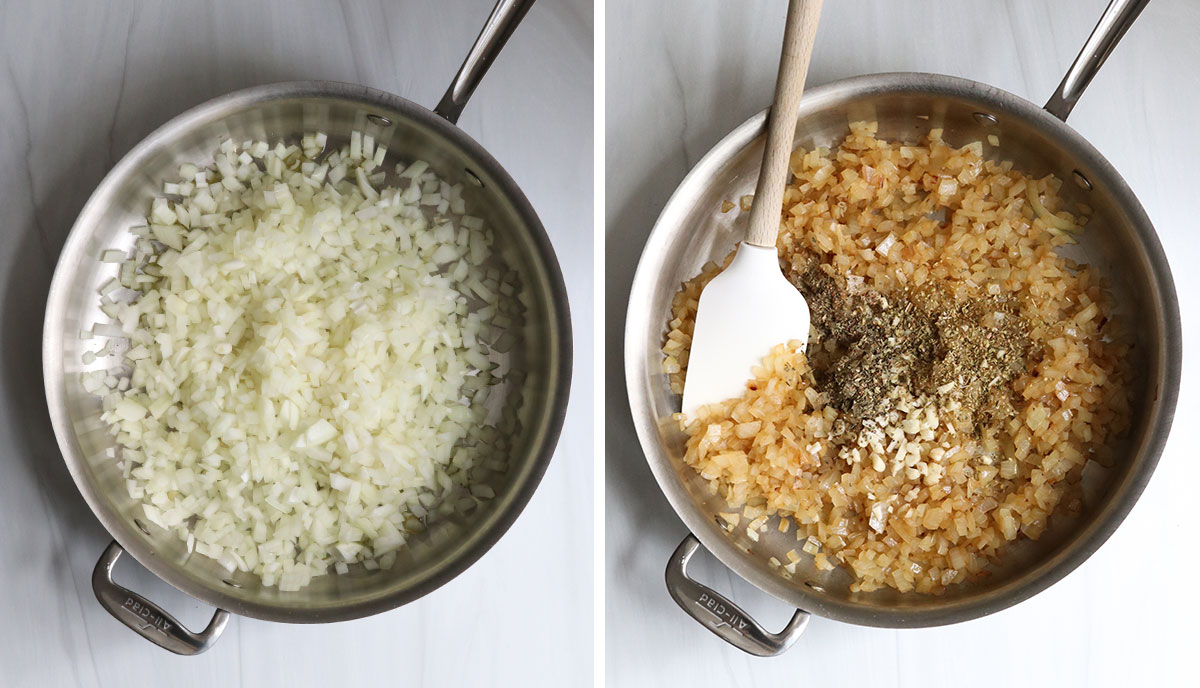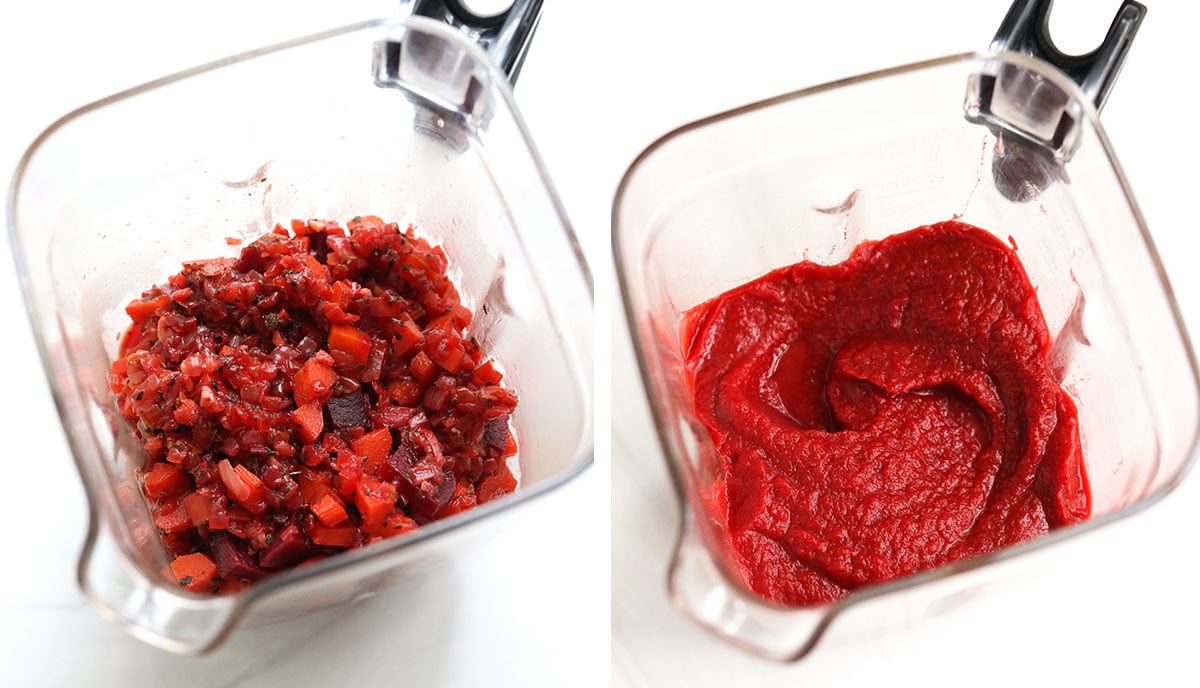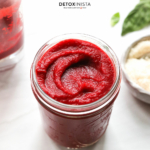This post may contain affiliate links. Please read my disclosure and privacy policy.
After years of developing and sharing healthy recipes, I’ve become aware of more special diets that need unique recipes. One of those is a diet that avoids nightshades. (Think: tomatoes, bell peppers, eggplant, potatoes, and chili peppers.)
I can’t imagine a world without a delicious marinara sauce, so that’s why I spent weeks testing this tomato-free spaghetti sauce. It’s made with beets and carrots, but still has a remarkably similar flavor to the traditional version.
If you or someone you love needs an alternative to marinara sauce or has a tomato sensitivity, I hope you’ll love this nomato sauce as much as I do. It’s the perfect topping for pasta, pizza, and more!
⭐⭐⭐⭐⭐ Featured Review
“First nightshade-free recipe my kids declared a hit! Thank you!!!”
-Judy

Nomato Sauce Ingredients
Here’s what you’ll need:
- Chopped Vegetables. Carrots, beets, and yellow onion make up the majority of this tomato-free sauce. When they cook, they become tender and naturally sweet!
- Garlic. Luckily, garlic is not a nightshade, so you can achieve a classic Italian flavor with as much garlic as you like.
- Olive Oil. This is used to saute the veggies, but you can use any other oil you prefer, too.
- Lemon Juice. This adds a bright, tart flavor that would normally come from the acidity in tomatoes.
- Spices. Dried oregano and basil are added to boost the classic marinara flavor. Feel free to use other Italian spices you enjoy, too. (But no red pepper flakes or chili powder to keep it nightshade-free.)

How to Make Tomato-Free Sauce
Step 1:
Heat the olive oil over medium heat in a large skillet with a lid. Add in the onion and sauté until it’s soft and translucent, about 8 minutes.
Add in the garlic, basil, and oregano and stir until they are fragrant, about 1 more minute.

Step 2:
Next, add in the carrots, beets, water, and 1 teaspoon of salt. Bring the liquid to a boil, then cover the pot and lower the heat, so the veggies can simmer until they are tender, about 25 to 30 minutes.

Step 3:
When the vegetables are soft and easily pierced with a fork, transfer them to a high-speed blender, along with all of the liquid in the pan.
Add in the lemon juice, then secure the blender’s lid and blend until the sauce has reached your desired consistency. (You can make it silky-smooth, or a little chunky, depending on your preference.) If you prefer a runnier sauce, you can add water 1 tablespoon at a time, until you are happy with the texture.
Safety Tip
When blending hot liquids, be sure to cover the vent in your blender’s lid with a thin towel, so steam can safely escape as you blend, without splattering. Otherwise, the steam pressure may build up as you blend, causing the lid to blow off your blender—which would be a very hot mess! Bullet-style & individual cup blenders are not ideal for blending hot liquids, since there is no venting option.

Serving Tips
Once the soup has been blended, adjust any seasoning to taste. If the beet you used was large, you may need to add more salt (just a 1/2 teaspoon at a time) to help counterbalance the sweetness of the root vegetable.
This AIP nomato sauce recipe makes roughly 4 cups, so you can store any leftovers in an airtight container in the fridge for up to 5 days. Or, you can freeze it for up to 3 months. (Be sure to leave a little room at the top of your storage container, so it has room to expand as it freezes.)


Ingredients
- 1 tablespoon olive oil
- 2 yellow onions , chopped (about 2 cups)
- 4 garlic cloves , minced
- 2 teaspoons dried basil
- 2 teaspoons dried oregano
- 1 pound carrots , peeled and chopped
- 1 medium beet , chopped (about 1 cup)
- 1 cup water
- 1 teaspoon sea salt
- 2 tablespoons fresh lemon juice
Instructions
- In a deep skillet (with a lid), heat the olive oil over medium high heat. Add in the onion and sauté until it’s soft and translucent, about 8 minutes. Add in the garlic, basil, and oregano and stir until it’s fragrant, about 1 more minute.
- Add in the carrots, beet, water, and 1 teaspoon of salt, then bring the liquid to a boil. Cover the pot with a lid, and lower the heat to a gentle simmer. Cook until the beets and carrots are fork-tender, about 25 to 30 minutes.
- When the vegetables are soft, transfer them to a high-speed blender, along with all of the liquid in the pan. Add in the lemon juice, then cover the blender with a lid.Safety Note: Make sure that the steam can safely vent out of the lid, so the steam pressure won’t make the lid pop off during blending. (Cover the vent with a thin dish towel to prevent splattering.)
- Blend until the sauce is smooth, then adjust the seasoning to taste. Depending on how large the beet is that you used, you may need to add more salt. I start with a 1/2 teaspoon at a time (for a large beet you may need to add 1 extra teaspoon of salt in total) to help counterbalance the sweetness from the root veggies.
- Transfer the sauce to an airtight jar with a lid, and store it in the fridge until you’re ready to use it. This sauce makes an excellent alternative to marinara sauce, so you can use it over pasta, pizza, in lasagna, and more. The sauce will keep well in the fridge for up to a week, but you can also freeze it for up to 3 months. (Just be sure to leave some extra room at the top of the jar, to allow for the sauce to expand as it freezes.)
Video
Notes
Nutrition
More Recipes to Try
If you try this recipe, please leave a comment and star rating below to let me know how you like it.













I had all but given up ever enjoying my favorite Italian food recipes again until I found your recipe. I made the sauce yesterday for the first time and I am so excited! It is absolutely delicious and makes the whole house smell like tomato sauce is cooking on the stove. I just put a small lasagna in the oven. I can’t wait.
It’s been 7 years since I had to give up tomatoes and all acidic foods. Thank you so much!!